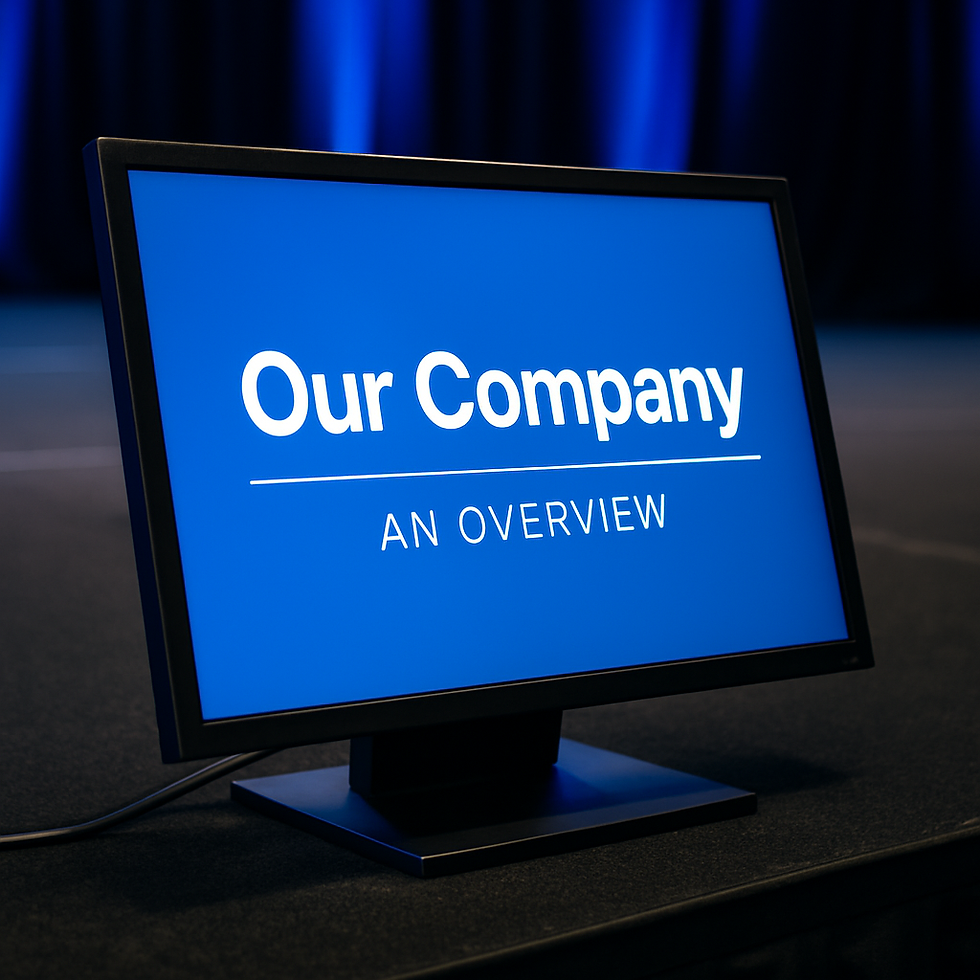Enhancing Presentation Impact: The Role of Confidence Monitors for Engaging Large Audiences
- mharris7892
- Jul 16
- 3 min read
Presenting to large groups can be intimidating, especially for those new to public speaking. To help ease this fear, one valuable tool is the confidence monitor. These monitors, positioned at eye level, allow presenters to stay connected with their audience while keeping track of their presentation materials. In this post, we will delve into the benefits of confidence monitors, showcasing their necessity for effective communication.
What Are Confidence Monitors?
Confidence monitors are display screens that show key content, speaker notes, or any relevant information to the presenter. They are strategically positioned at eye level or slightly below, enabling presenters to glance at their slides without turning away from the audience.
In larger venues, turning your back to the audience to read from a projector screen can cause a disconnect. Confidence monitors solve this issue by making sure the presenter stays focused and engaged with the audience, enhancing the overall communication experience. For instance, a study found that presenters who maintained eye contact had a 20% better retention rate among their audience compared to those who frequently looked away.

Benefits of Using Confidence Monitors
1. Enhanced Engagement
Using confidence monitors significantly improves audience engagement. When presenters can maintain eye contact while navigating through their materials, they foster a stronger connection. A connected audience is not just passive; they are more likely to ask questions and provide feedback.
For example, during a recent business seminar, presenters who used confidence monitors reported a noticeable 30% increase in audience participation compared to those who did not. This boost in engagement can make a considerable difference in the effectiveness of the presentation.
2. Reduced Anxiety for First-Time Presenters
For first-time speakers, the fear of forgetting what to say can be overwhelming. Confidence monitors act as a helpful reference, allowing presenters to verify their notes without losing focus on the audience.
Many first-time presenters feel overwhelmed by memorizing content. Research indicates that 75% of individuals experience nerves before making a public presentation. With the support of a confidence monitor, they can focus on delivering their message rather than worrying about forgetting lines. This tool provides essential reassurance, enabling them to gradually build confidence in their public speaking skills.

3. Improved Delivery and Pacing
Confidence monitors also help presenters control their pacing. Rather than rushing to finish points before turning to the screen, they can maintain a steady flow. This careful control allows presenters to elaborate on vital points and ensures that their messages are clear.
A recent survey showed that 85% of audience members prefer a presentation that includes pauses for emphasis and engagement. With a confidence monitor, presenters can more easily incorporate these pauses, leading to a more polished and professional overall delivery.
Practical Tips for Implementing Confidence Monitors
1. Choose the Right Setup
When using confidence monitors, consider the layout of the venue. Ensure that the monitors are positioned for easy glancing without breaking their connection with the audience. This setup maximizes visibility and minimizes distractions.
2. Customize Content Display
Take advantage of the flexibility provided by confidence monitors. Display essential points, prompts, or cues to assist in delivering your presentation. Customization is key, as it helps you to recall important information without overwhelming yourself with too much text.
3. Rehearse with the Monitors
Before your actual presentation, rehearse using the confidence monitors. This practice familiarizes you with the setup and helps you learn how to pivot smoothly between engaging with the audience and checking your content.
4. Utilize Visuals Wisely
When using confidence monitors, avoid overcrowding them with information. Stick to visuals, bullet points, or simplified text that enhance your message. Remember, the purpose is to aid communication, not to distract from it.
Overcoming Common Misconceptions
1. The Monitors Are Distracting
Some may fear that confidence monitors can distract from a presentation. However, when used correctly, these monitors can actually enhance focus and engagement. The key is to ensure they support communication without becoming overwhelming.
2. Only Experienced Speakers Should Use Them
A common belief is that confidence monitors are only for seasoned presenters. In reality, they are beneficial for speakers of all experience levels. Confidence monitors create an environment that nurtures growth, enabling everyone to improve their public speaking abilities.
The Final Thought
Confidence monitors are essential for enhancing the presentation experience, particularly when addressing large groups. They allow presenters to maintain eye contact and stay focused on their audience.
These devices are especially valuable for new speakers who may struggle with anxiety and pacing. Utilizing confidence monitors helps presenters deliver their messages with conviction and clarity, leading to more impactful presentations. As we adapt our presentation techniques, embracing confidence monitors can effectively bridge the gap between speaker and audience, creating memorable exchanges of ideas.








Comments